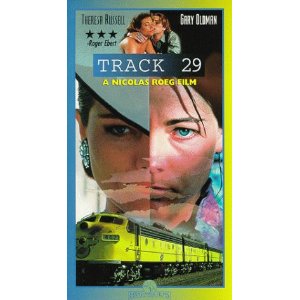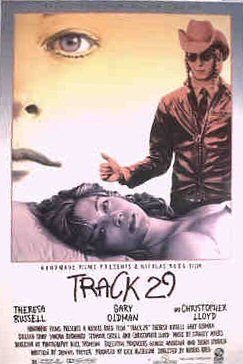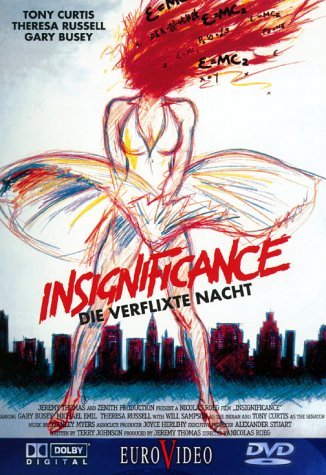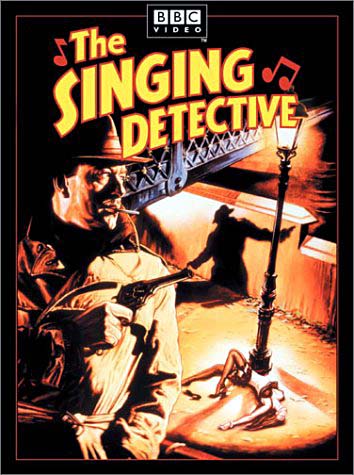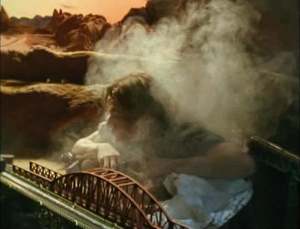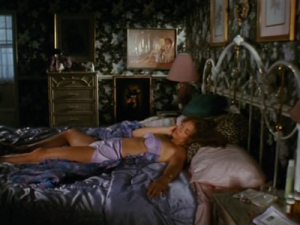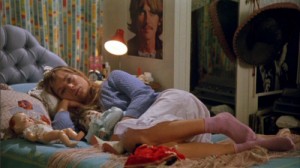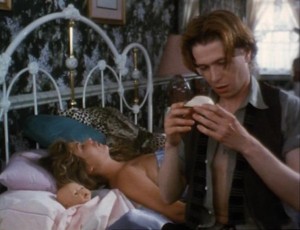From the Chicago Reader (October 14, 1988). — J.R.
TRACK 29
** (Worth seeing)
Directed by Nicolas Roeg
Written by Dennis Potter
With Theresa Russell, Gary Oldman, Christopher Lloyd, Colleen Camp, Sandra Bernhard, and Seymour Cassel.
As a rule, I tend to be favorably disposed toward non-American movie depictions of American life, at least as a source of fresh perspectives. If we accept the premise that the U.S. continues to function as a stimulus for fantasy projections all over the world, here as well as everywhere else, it stands to reason that European projections about America would at least have the virtues of relative distance and detachment. Consequently, movies as diverse as Bunuel’s The Young One, Antonioni’s Zabriskie Point, Passer’s Born to Win, Demy’s The Model Shop, Wenders’s Hammett and Paris, Texas, and even — to cite two recent and contentious examples — Konchalovsky’s Shy People and Adlon’s Bagdad Cafe have things to tell us about this country that we would never learn from the likes of John Ford or Frank Capra. The truths of these movies may be more oblique and specialized (and harder to encapsulate) than those of our semiofficial laureates, but at least they give us some notion of how we look to outsiders.
This is one of the reasons I had unusually high expectations regarding Track 29. Another reason was the apparently inspired pairing of screenwriter Dennis Potter and director Nicolas Roeg, two dark poets of psychic subtexts and achronological memory flashes. (Both of them might be regarded as English offshoots of Alain Resnais, the contemporary master of fragmented subjectivity.) Potter and Roeg both previously have shown some aptitude for provocatively juggling and reprocessing certain American myths — Potter in Pennies From Heaven and The Singing Detective, Roeg in Insignificance. It seemed to augur something special.
The problem with that kind of thinking is that it commits the same error commonly seized upon by producers: it assumes that creating a work of art is a matter of following certain recipes. In point of fact, Track 29 is not totally devoid of the virtues promised by the collaboration of Potter and Roeg on an American subject, but it is not a simple matter of addition and multiplication, either: Potter plus Roeg times America doesn’t equal exactly what you’d expect, because each of them tends to cancel out portions of the others. If a formula of some sort is needed, Roeg versus Potter versus America may actually come closer to the mark.
Part of the difficulty in the combination of these three elements is the absence of any clear dialectic between them. The fragmented, stream-of-consciousness styles of both Roeg and Potter usually require a strong sense of objective reality, a grounding that allows their subjective visions to take flight. Theoretically, the plot and social observation of Track 29 could serve this function if they were sufficiently strong, but unfortunately they serve as ballast more than as structural support.
What there is of an objective plot and setting is remarkably slender. It concerns the unhappy marriage of Dr. Henry Henry (Christopher Lloyd) and Linda Henry (Theresa Russell), who live in a small town in North Carolina. The husband, obsessed with his model trains, contemptuous of Linda’s drinking, and sexually indifferent to her, grows increasingly neglectful of his work at a geriatric hospital, where his principal interest is his mistress Nurse Stein (Sandra Bernhard), a dominatrix who spanks him with rubber gloves to the strains of bombastic classical music.
As a result, both Henry and Nurse Stein are fired by the hospital’s chief administrator (Seymour Cassel). They attend the Trainorama, a model-train convention, where Henry delivers the keynote address. While there, he is offered a job by a model-train company, which would involve moving and leaving his wife. He comes home to find Linda in a state of incoherent, drunken hysteria, accompanied by her best friend Arlanda (Colleen Camp), whom he sends home. The next morning, apparently coming to her senses, Linda leaves him.
This is roughly half of the plot. The other half, which is intercut with Henry’s activities, follows Linda over the same period, but it is impossible to synopsize objectively because its progress depends on another character, Martin (Gary Oldman), a young Englishman whose status as real or imaginary is never fully established. Martin, in fact, is the first character we see in the film, attempting to hitch a ride into town. Under normal circumstances we would accept him readily as real, but Roeg’s ambiguous ways of introducing and framing him establish certain doubts about his reality from the outset. Later in the film we learn that about 20 years ago, Linda, at 15, was seduced (or possibly raped) at a carnival by a worker who ran the bumper cars. She became pregnant. Apart from suffering from the blot this placed on her reputation, she was traumatized when her newborn son was taken away from her immediately after his birth and put up for adoption. She never saw him again, and has been haunted by this fact ever since. To compound her obsession, she is frustrated by her husband’s refusal to have or adopt a child. (Why she and Henry ever got married in the first place is a question that the film never addresses.)
As he hitches into town, Martin seems to exist independently of Linda, though there are certain anomalies about his character from the beginning. He becomes preoccupied with tattoos spelling out “Mother” on the arm and chest of the trucker who gives him a lift, and mentions that he never knew his own mother, who was American, and was taken away from her shortly after his birth. To complicate matters, in typical Roegian fashion, the nameless bumper-car operator whom we glimpse briefly in Linda’s subjective flashbacks is played by the same actor who plays Martin and bears a “Mother” tattoo on his own chest. If Martin has any objective reality in the film at all, it is during his very first encounter with Linda, when she is sitting with her friend Arlanda in a fast-food restaurant and he briefly joins them in their booth. But he carries no luggage and seems to be traveling at random, which raises some doubts about his reality even here.
When he later appears outside the Henry house at night, where he is seen only by Linda, and then turns up at their swimming pool the following day to declare himself her long-lost son, he is more clearly her fantasy projection — significantly, he turns up at the precise moment when she has sunk to the bottom of the pool, contemplating suicide — and this is what he remains for the rest of the film. (Although the film deliberately takes its time about confirming this, Martin’s unreality is later established beyond any doubt.)
Luc Sante has defined two traits in Dennis Potter’s work, “a neurotic obsessiveness that is transmuted into rhythm, and a penchant for dreams” — traits that “join in the faculty of memory” (and can be found in Dreamchild as well as Pennies From Heaven and The Singing Detective). The same traits are common to Roeg’s work, and the curious results in Track 29 are roughly akin to Mondrian’s White on White. The neurotic hang-ups of both Henry and Linda converge in a broad portrait of American regression and infantilism; it’s a portrait supported by everything from Henry’s model trains and his desire to be spanked to Linda’s collection of dolls and the braces on her teeth, and it is given even more direct expression by Martin’s infantile behavior (including his polymorphous perversity). But the satirical thrust of this portrait is considerably weakened by many behavioral details that appear throughout the film.
The southern accents of Theresa Russell, Christopher Lloyd, and Sandra Bernhard are downright shabby — inconsistent and inaccurate. Russell tries hardest, but her efforts are plainly visible, and the efforts of the other two are only intermittent. Moreover, the depiction of the local milieu is so patchy that it scarcely can be said to exist at all. Potter’s original script was set in Texas, and evidently no attempts were made to adjust it to a North Carolina setting, the assumption apparently being that the south is an undifferentiated mass where everyone talks and acts the same way.
The name of Lloyd’s character, Dr. Henry Henry, is a clear allusion to Humbert Humbert in Nabokov’s Lolita, which has its own spirited satire on American vulgarity and arrested development, but it’s a reference that backfires. There’s a world of difference between Nabokov’s amused treatment of American folkways and Roeg and Potter’s hysterical, scattershot treatment of a model-train convention in which the audience’s frenetic responses to Henry’s ludicrously overheated address resemble those at a fundamentalist revival. (See Jean-Pierre Gorin’s Routine Pleasures for a witty and intelligent treatment of the same subject that doesn’t bend reality.) Indeed, far from resembling Lolita, this sequence recalls the smugness of sections in Nashville that blithely ignore the reality of both Nashville and country music for the sake of “larger,” unfocused jabs against America in general. The use in Track 29 of an actual Trainorama only compounds the imposture and distortions involved.
I suspect that Roeg is more to blame for these lapses than Potter because it was he, after all, who failed to respond to the film’s physical and social settings, and because his own style suggests that he uses scripts more as taking-off points than as final destinations. I would guess, for instance, that the profusion of TV sets in the Henry household, which periodically allow him to punctuate and/or parallel the action with thematically relevant snippets from TV shows — even when this obliges him to manipulate the sound in these programs unrealistically — is his own contribution. Indeed, the overall emphasis of style over substance is more characteristic of Roeg than of Potter, and even if this approach has its compensation –much of the kick in his rapid editing patterns and imaginative fantasy-flashes depends on it — its limitations have to be acknowledged as well.
Roeg has pointed out that Track 29 places more emphasis on acting than his previous features, and because of their monotonal performances, Russell, Lloyd, and Bernhard all seem to suffer as a consequence. Oldman, however, turns out to be a beneficiary of the same strategy. Because the reality of his character is perpetually in question, he is free as the others are not to ignore verisimilitude and act up a storm, working his way through diverse rages, tantrums, effusions, and lightning-quick mood changes in a theatrical performance that remains relatively abstract rather than anchored in any recognizable social reality (although it may occasionally remind us of his Sid in Sid and Nancy). In a way, the stylistic freedom of Oldman resembles that of Roeg insofar as his performance often luxuriates in style for its sake, for better and for worse.
The ironic uses that Potter makes of popular songs in Pennies From Heaven and The Singing Detective are invariably grounded in social and psychological meanings, so it seems significant that he’s only allowed one such foray here – -Oldman’s rendition of “Mother” at a piano. Like Russell, Lloyd, and Bernhard, Potter seems constrained here in a context where only the stylistic gymnastics of Roeg and Oldman — freed as they are from the contours of a particular reality — are able to shine.

